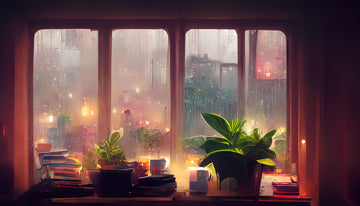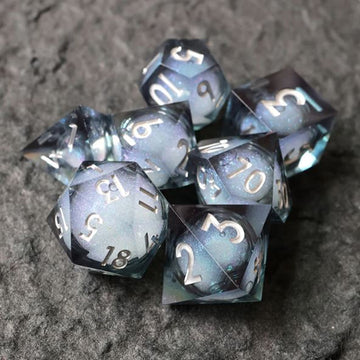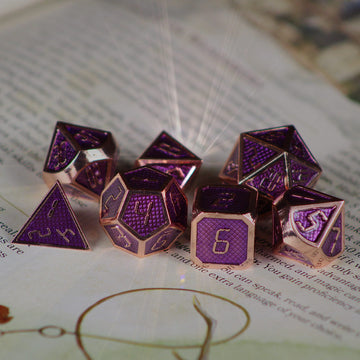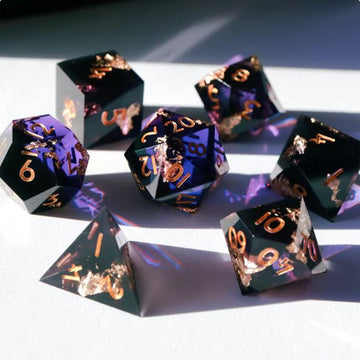Enhancing Adventures with DnD 5e Weather
Learn why weather can be an important part of storytelling and how to incorporate it into your TTRPG campaigns.
Table of Contents
- I Am NOT a Weather Expert!
- Categories of DnD 5e Weather
- The Role of Weather in Famous Stories
- DnD 5e Weather as a Storytelling Tool
- Symbolism for Different Types of Weather
- DnD 5e Weather Combat Encounters
- Official DnD 5e Weather Rules
- DnD 5e Weather Generators and Random Tables
Introduction: I Am NOT a Weather Expert!!!
I just want to paint a picture for you real quick...
I am writing this blog post outside, on my grass, shirtless getting sunburned... in MARCH. This is in Spokane WA, longitude 47.6580 N°, where it is 70 (S-E-V-E-N-T-Y) degrees when usually the highest high for this time of year is 60. As you can imagine, after a dark (tho not so cold) winter, I am cool as a cucumber sipping on some iced tea.
And I can't think of a better example to illustrate how much weather impacts our daily lives. It affects our moods, activities, and even our health! And here's the thing: weather can also make our Dungeons & Dragons games better!!!
In this blog, we will explore the various ways in which weather can be incorporated into your DnD campaigns, making them more immersive and exciting.
DISCLAIMER: Now, let me be clear, I am NOT a weather expert. I promise to try, but please do not take any "weather term" definition as gospel. I am not the National Weather Service. The best thing you can do is comment at the bottom of the post with corrections. That said... I do know a thing or two about how weather can add depth to storytelling and game play, so let's hop to it.
Categories of DnD 5e Weather
For simplicity's sake, lets establish that there are two types of weather: normal and extreme. And both are relative for the ecosystem and season: 40 degrees and downpour is EXTREME in the Sahara desert, while 80 degrees and sunny is UNTHINKABLE for Seattle 9 months of the year (okokok, that's an exaggeration... I'm in eastern Washington, so I had to make ONE joke about it...)
Like I JUST SAID... I am not a meteorologist, so I am POSITIVE there are more categories than this. But unless one of your players IS a meteorologist, then I doubt it will make a big difference.
Normal DnD 5e Weather
Normal weather refers to the everyday weather conditions that occur on a given day. This includes the basics: wind, snow, rain, sunlight, clouds, fog, temperature, and humidity. "Normal" meals appropriate weather for the season and location, and if the player characters were wearing seasonal-appropriate clothing, they would NEVER have to roll a survival check. Normal weather sets the baseline for your 5e adventures and has small mechanical impacts (if any).
Now this is very much a "no duuuuuuh" little section of the blog, but it's important to establish that if you want to incorporate more DnD 5e weather into your campaigns, you need to narrate even the banal stuff. And here is why (I beliiiieve I got this idea from Terry in the It's a Mimic Podcast):
You don't want descriptions of the weather to tip players off to a special combat encounter.
Most standard weather will not impact game mechanics at all. But if you ONLY mention the rain when they are fighting a storm giant, or only mention an earthquake when an earth elemental is about to burst forth, you will have given away your surprise prematurely.
So before you incorporate DnD 5e weather to make better social, exploration, and combat encounters, you need to 1) include the atmospheric conditions in the setting description and 2) have some variety even when it will not impact the encounter in any way.
Extreme DnD 5e Weather
Extreme weather includes weather conditions that go beyond the norm of any random location. They might include strange weather patterns, temperature extremes, or exaggerated versions of what is normal. Think scorching heatwaves, freezing blizzards, torrential rainstorms... etc. And since the potential consequences of these are life threatening, exciting, terrifying experiences for any adventurer, a lot of you want to weave THESE DnD 5e weather events into your shared storytelling. And damn right: they are THRILLING!
Another category that is included in this section would be MAGICAL WEATHER. Magic might be the CAUSE of the chaotic elements (as in the eternal winter of the White Witch in the Lion, the Witch, and the Wardrobe or Auril in Rime of the Frostmaiden) or the elements themselves could be magical. A silly example might be it LITERALLY rains cats and dogs. A more serious example might be a LITERAL meteor shower wrought upon an area by an evil lich.
That said, if you are adventuring in a high fantasy campaign, I imagine that, sometimes, magical dnd 5e weather patterns are NORMAL for certain parts of the world.

© Saša Radivojević for RuneQuest
The Role of Weather in Famous Stories
"Weather is LAME! Adventures are about cool things like monsters and cursed items!"
I doubt any of the readers are ACTUALLY saying that out load... but I have had several players that FEEL something similar to that (looking at YOU B.L.): being aware of weather in your DnD campaign is a waste of time. DnD is already so complicated... why add this other level that often won't impact the game? We'll address the mechanics behind DnD 5e weather later on, but right now I want o address the fallacy that "cool adventures don't include weather."
On the contrary... MOST ADVENTURERS INVOLVE WEATHER!
Because in most worlds and stories, weather is somewhat unpredictable, which means it is weather that gets in the way of character plans. I mean, come on, we ALL have a childhood birthday party that was suddenly shifted to a bowling alley when some lightning and thunder made the park a non-option!
Weather THWARTS the plans of people, making it an excellent foil to bring exciting twists and turns to an adventure. Let's start with history... yes, it is written by the victors, but more than a few times the victors were only victors because some clouds and winds made them victorious:
- The "Divine Wind" Kamikaze typhoons that ended the dreaded mongol invasion of Japan in the 13th century.
- Rainy day muddying the fields of Agincourt so the English could defeat the French in 1415.
- Nazi Germany failing to reach Moscow due to the extreme winter cold of 1941 that brought Operation Barbarossa to a grinding halt.
- The extreme desert heat and lack of water being the reason crusaders lost the Battle of Hattin in 1187.
Often, without weather, there is no story!
And just as the machinations of great men and women in history have been thwarted by a rainy day, so too are the plots of our favorite stories steered in a different direction due to weather patterns:
- The rain in Singin' in the Rain reflects the characters' overwhelming emotions and carefree attitude.
- The tornado in The Wizard of Oz transports the protagonist to a magical realm and sets the stage for adventure.
- A cyclone forcing Aang into the avatar state is the only reason the plot of Avatar: The Last Airbender could have existed!
- The snowstorm in The Shining traps the family in the Overlook Hotel.
- The thunderstorm in Jurassic Park sets of the entire plot when Dennis Nedry enters the virus, shutting down all the fences around the dinosaurs.
- In The Lord of the Rings, the fellowship enters Moria only after Saruman creates a dreadful blizzard atop Mt. Caradhras.
- The characters in The Perfect Storm choose to risk their lives to keep their catch, setting up an unforgettable, tragic ending.
- Andy Dugrene chooses to make his mistake the night of a thunderstorm, which will hide the sounds of his banging a rock on the metal pipe.
- An entire horror movie, The Mist, takes place in a heavily fogged environment, causing all the characters to go mad, sacrificing each other and committing suicide.
Additionally... weather affects travel... which affects adventure.
A rainstorm might keep a party in a cabin a little bit longer, only for it to be raided by bandits desperate to get around a warm fire. A sandstorm might lead the characters to an ancient desert temple where they must solve puzzles and battle mystical creatures to survive. A sudden blizzard might force the party to seek shelter in a haunted mansion, uncovering hidden secrets and unraveling a dark mystery.
On the flip side, weather is something your players need to SURVIVE. Whatever local weather they face, a good rule of thumb is to travel with the proper gear like a large tent, or at least have the tools to fashion a proper shelter for a long rest. Awfully hard to make good attack rolls when you are moving at half speed or taking levels of exhaustion!
Long story short: weather can determine what options characters have as much as any villain, forcing the plot of the story to move in an entirely different direction. It isn't an "add on" to stories... it is often an ESSENTIAL aspect of the story itself. You want an adventure? Then you need weather!

DnD 5e Weather Systems as a Storytelling Tool
Later on in this blog, we will talk about HOW you can add more DnD 5e weather into your adventure, but first I want to tackle WHY you should consider adding it in the first place. Simply put: it can set the scene, create symbolism and foreshadowing, and generate memorable moments for your players.
Setting the Scene
A big selling point for TTRPGs is that they are IMMERSIVE escapism: players use their imagination to escape the real world and both enter and inhabit a fictional world. The DM helps facilitate this with a combination of visuals and evocative narration to help player imagination blossom.
A popular suggestion is to incorporate all five of the character's senses into the descriptions: sight, hearing, smell, taste, and touch. And nothing impacts ALL of the senses like the weather. If I step outside on a winter day, I will SEE snow, HEAR the crunch of the ice under my boots, SMELL the fresh clean air, TOUCH heavy wool clothing, and TASTE... I dunno, I guess my own bad breath cuz there is a scarf around my face.
Another point: when you describe your DnD 5e weather, don't just say "it's raining"... describe the weather by showing how the environment is reacting. For example, instead of just saying "it's raining," talk about how the cats are all racing to get under a covered porch, or a street peddler is trying to sell umbrellas! Ultimately, no setting is complete without including the atmosphere it is in.
Establishing the Mood
As stated in the introduction, the weather around us has a huge impact on our emotional state. A sunny day with clear skies might evoke a sense of joy and optimism, while a stormy night with thunder and lightning might stir up some anxious feelings. I believe this is because there are aesthetic qualities to the weather, which impact us emotionally.
TRANSLATION: DnD weather can help set the TONE of your adventure, laying the groundwork for upcoming encounters or adventurers (Barovia in Curse of Strahd comes to mind). That said, other times you can use DnD 5e weather as misdirection for your players. Not to get too morbid, but maybe they are witnessing a keelhauling while the sea is calm, or come across frost giants playing frozen boulder baseball during a blizzard.
Creating Memorable Moments
"Rule of Cool" exists for a good reason: our tables want to go on an exciting adventure that features epic set pieces. The cooler the player's action, weapon, battle map... the better! By using DND 5e weather to create dramatic backdrops and effects, you can make your players' experiences unforgettable.
For example...
Fighting a leviathan is cool... but it's COOLER to fight it in a hurricane. And a high-stakes chase (view our rules here!) throughout a city is cool... but it's COOLER if high winds are making long-ranged attacks impossible. And exploring an ancient tomb is cool... but it's COOLER if one of the traps creates a m$th#r f^ck@ng TORNADO in a hallway!!!
Clearly, the right weather can take an awesome encounter and make it AWESOME-ER! But there is one more way DnD 5e weather can impact your storytelling... SYMBOLISM.

Symbolism for Different Types of Weather
In the normal, objective world, the weather is just part of the environment. But in stories, it is more than the setting... it SYMBOLIZES things. Whether or not you believe in universal truths or Jung's collective unconscious, the weather has always symbolized SOMETHING in myths, fables, epics, fairy tales, legends, etc.
All throughout your adventurer, players are developing and building characters; their emotions, goals, and motivations fluctuate as they struggle against challenges. It's what makes our player characters so INTERESTING to everyone at the table. So what do you do when you want to A) create awesome settings for encounters and B) help develop the PCs?
MIRROR THE DnD 5e WEATHER WITH THE MOMENT.
Let the symbolic meaning inherent to the weather contribute to powerful character moments! Of course, to do this, you need to know what the weather symbolizes! Below are brief summaries of the traditional symbolism behind common weather patterns:
Sunny Day
The sun is THE energy source of the solar system, so it's no surprise that it is the dominate image of any form of creative energy, which equals LIFE. And since life is good, the sun radiates all things good: hope, love, joy, and growth. Until Copernicus, it was considered the center of the cosmos... the sacred heart that beat at the center of creation.
The sun is also LIGHT, and light shines in the darkness, chases the darkness, and reveals what is in darkness. Similarly, an ignorant mind is "illuminated by truth," so the sun is a symbol for truth and knowledge and an enlightened consciousness.
However, the sun is also HOT, and just as the intense heat of the sun can burn away impurities, so too is it a painful purification, forcing characters to confront their flaws and past mistakes.
Desert (i.e. "too much sun")
The desert is technically a climate... but there is a clear different between a sunny day in Virginia and Arabia. A desert is a land out of balance: too much sun, not enough water.
In this ecosystem, the sun takes on very different ideas: rather than a source of life, it has created a land of death. It is dry, sterile, lifeless... nothing can grow in the inches of sand... just like how people cannot grow when they are stuck in a lifeless belief/attitude. Furthermore, it is a hostile, rugged terrain and climate that offers only obstacles to any that venture into it. In a desert, you cannot thrive and yet you must survive... a perfect metaphor for characters whose lives are a constant struggle or are stuck in a lifeless stage.
However, many characters go to a land of death because there is something about them that NEEDS TO DIE. Perhaps it is hatred, pride, or fear? Heroes often enter a desert and metaphorically die so they may experience a necessary rebirth.
Another thing about deserts is that they are EMPTY. There is nothing there, and therefore visitors can see for miles in a way they never could unless they were on a mountaintop. In other words, it's free of confusion, making it a perfect place for REFLECTION. Heroes enter the desert, an empty place, as they try to empty their mind and confront ultimate realities, and receive some sort of revelation?
Clouds
Clouds do one thing: they hide the sun. As such, they have always been a symbol for anything that gets in he way of humanity attaining their divine potential. Clouds are often used when characters cannot see their potential or are blocked from receiving necessary illumination. Also, we have all experienced a gloomy, cloudy day... and often that is what a cloud represents: a sorrow-filled, heavy heart. The meloncholy of heavy clouds can reflect the despair or doom in a character.
On a positive note... clouds can appear light, soft, almost pillowy... kinda like a baby! Which is why some cultures associate clouds with optimism and youth.
Rain
Rain was considered the primarily tool of the gods to elicit worship, for it could be withheld as punishment, UNLEASHED as punishment (more on floods in a bit), or gently measured as a necessary blessing. Rain brings life to barren lands, nourishes crops, and replenishes water sources. Just like blood in the human body, it is the liquid of life for the land. It can represent blessings, renewal, and cleansing.
On the other hand, humans cry... and rain is like the sky crying. So rain can also represent the tearful misery of a heavy heart. A heavy downpour might mirror a character's inner struggles or reflect a tragic event. But rain is also water, which cleans clothes, and the falling of rain can represent inner cleansing or a bestowing or mercy.
The NSFW answer: ancient cultures saw how rain fertilizes the ground... kinda like sperm to an egg... so it symbolized fecundity. Which I guess would be perfect if your party contains a particularly horny bard who messed around with a particularly fertile dragon...
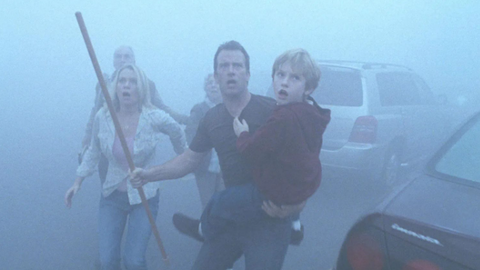
© Darkwoods Productions and Stephen King
Fog and Mist
When you are in fog, you can't see what you normally would on a clear day. Heck, sometimes you can barely see what's right in front of you. I've driven in fog so thick I had pulled up to a stop sign, turned off my car, and LISTENED to see if there were other cars coming!
Fog is all about the UNKNOWN. The unknown can be anything illusory, unconscious, dreamlike, spiritual, or imaginary, but it's not pure ignorance. A person knows something is out there, but it is obscured, blurred, and indeterminate, so they do not know exactly WHAT it is. Reality is shrouded in secrecy and mystery.
Fog also feels very in between... it isn't dark or light... it isn't rain or dry... it's neither and also both. For this reason, it is a physical representation for characters in liminal spaces. They are blended between two beliefs, callings, identities, etc. and need to transition and choose who they will become.
Floods
A flood is when rain goes CRAAAAAZY; what was once considered good and necessary is now a terrifying, unstoppable force of destruction. Hence, the majority of ancient cultures have some sort of flood myth, where divine punishment is unleashed upon the world. It is a form of retributive justice: the unjust, cruel, and evil finally meet a deserving end.
However... floods also SUBMERGE the world... the same action for washing, cleaning, and baptizing. What goes under is dirty and what comes up is clean. Think like the rain at the end of The Lion King... it acts like a flood, washing away the filth of Scar's rule, purifying the land to make way for a fresh start of regeneration and resurrection.
Wind
Because wind is a hidden force, present and powerful yet invisible to the human eye, it has always symbolized spiritual realities and truth. Divine messengers arrive upon the moderate winds to bring good news, while demons ride strong wings to curse with evil and illness. In some ancient languages, the word for "wind," "spirit," and "life force" are actually the same.
But while wind can be gentle... high winds can rip whole trees from the ground. It can be an uncontrollable raw force (like a tornado) that leaves a wake of chaos and destruction in its path.
Another aspect of wind is its wildness. It is ever free and utterly independent, constantly changing direction and speed whenever it wills. This has lead others to use it as an illustration for how quick and fleeting life can be.
Snow (and Blizzards)
Lands like a few inches of snow because it allows the soil to REST and prepare for planting in the spring. It falls gently in pure white flakes, creating a peaceful atmosphere to walk and contemplate. This is why snowy weather is often used when characters are in a state of stillness and serenity, reflecting on the past and the future.
However, when snow is in storm form, it becomes something else entirely. Blizzards represent the harshness of winter, the struggle for survival, and the bitter cold grip of death. Things that are frozen do not move, and characters stuck in a blizzard often face an internal storm that they refuse to grow from. Unlike a desert, which is also harsh and deadly, a blizzard is much more active: avalanches, falling through snow, snuffing out fires... there is so much more to FEAR as the snow can, at any point, turn on you.
Storms
Finally... the BIG KAHUNA of symbolic weather. There are so many things a storm can represent, mostly because it takes on different forms based on the climate; a storm in a desert is going to have a different impact than a storm on a tropical island. They also have varying levels of intensity; a thunderstorm may be awe inspiring, but a hurricane is life-threatening.
That said, here are a few symbolic elements to a storm that are universal:
Raw Power: First and foremost, storms are powerful. Clouds, wind, and rain all intensify and cooperate to shake the earth itself. Whether it be elemental, spiritual, magical, or physical forces... revealing them in the midst of a storm is a perfect way to reflect just how POWERFUL these new forces are.
Divine Anger and Creativity: Zeus's lightning bolt... Thor's hammer... YHWH's voice... storms often reflect the will and energies of divine beings. This power can be punishing, but it can also be creative and communicative. Beings hidden in heaven finally reveal their power for all to see, making storms the perfect moments for characters to experience true clarity on the nature of themselves, their situation, or reality.
Turbulent Emotions: Despite their awesomeness, storms are normal. They happen all the time. The necessary components of a storm build over a period of time until, when the atmosphere cannot contain any more any longer, it is unleashed upon the earth. And yet, while storms "love" the earth, they often hurt the earth with their fury. Everything I just said applies to human emotion as well. A great way to show a character is feeling intense emotions is to place them in the midst of a storm.
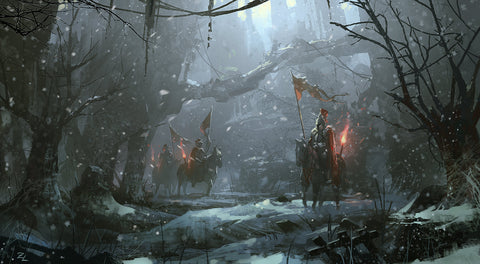
© ZUDartS Lee
DnD 5e Weather Encounters
WOW... ok, if you didn't just skip here, then you know we just covered A LOT so far:
- Differentiated normal vs extreme weather
- Adventures almost always include weather
- Weather sets the scene and tone, and creates memorable moments
- It is symbolic and can be used to illustrate and reflect character growth
But all that is mere narration and potential... how do you, oh thoughtful DM, make DnD 5e weather a bigger part of your adventurers?
The answer is shockingly simple: 1) you make it so they cannot ignore it, and 2) if they do, you expose them to danger (i.e. make them PAY). Because here is the simple fact as to why DnD 5e weather is frustrating, but fun:
Weather makes everything HARDER for players.
The next section has all the official and homebrew mechanics for different types of weather, but all of them basically do one of the following four things:
1) Weather Creates Difficult Terrain
Heavy snow might make running through certain areas slower and more arduous. And a muddy battlefield after a heavy rain can make it harder to maintain balance. Open flames control the battlefield and force characters in certain directions. All of these are examples of DnD 5e weather creating difficult terrain, which impacts player movement and speed per round.
Usually, it forces them to succeed some sort of Strength or Dexterity saving throw. If they fail, their movement is reduced by 1/2 or they stop moving or they fall prone, and other times they even suffer a condition! And in a combat encounter where being able to A) flank, B) jump out of the way, or C) race over to provide a healing potion to a fallen comrade, such restrictions can be DEVASTATING to your players.
Pssst! Looking for some easy inspiration? The following spells cause difficult terrain: Grease, Erupting Earth, Entangle, Ice Storm, Wall of Water, Web, Maelstrom, Sleet Storm.
2) Weather Impacts Visibility
Snow has a way of blinding your vision when it is blowing in your face. And sand gets in your eyes if you are standing in the middle of a greater dust storm. Heavy rainfall or thick fog has the same effect. When the weather gets rough, seein' can be TOUGH.
Now, I wrote a whole post on understanding and improving upon visibility rules in DND 5e (it's THOROUGH... read it here). Seriously... go read it... because it helps explain the two things visibility does to players in a combat encounter: 1) it makes it nearly impossible to meta-game, especially if some players are succeeding their Perception checks and others are not, and 2) it fills the combat encounter with fear of the unknown. This is especially true if the monster they are fighting is having no issues with visibility, while the players are nearly blinded.
This also turns the encounters into a fusion of combat and exploration, as they have to discover what is on the battle map and what they might be fighting (an example of a combat/exploration encounter is THIS blog post. An explanation of the entertaining power of discovery is THIS blog post).
3) Weather DnD 5e Skill Checks
We have already covered how DnD 5e weather effects could impact player movement. But even if the DnD 5e weather effects do not restrict movement, they can still hamper actions! For example: have you ever tried to pick up a piece of paper when it is blowing in the wind? Yeah... a little harder! Now imagine moving around in heavy armor with torrential precipitation, all those thick layers of cloth soaked in water... A LOT HARDER. Another blog (which I cannot find atm) called this "manipulation effects."
So are there high winds? Then not only do ranged spell attacks have disadvantage, but maybe just NOTCHING the arrow is a Sleight of Hand check. Is the mist particularly thick? Then demand players make a Perception check to defend against the swing of a sword, and if they fail, lower their AC for a round by 1 or 2. Is the magical storm picking up? Then perhaps have spellcasters make an Arcana check to see if their spell goes off as normal. Even if you set a low DC, such conditions will impact the combat across a number of rounds!
4) Weather Creates Advantages/Disadvantages
This one is more homebrewed because it follows Pokemon rules (shout out to Demogorgon... I mean... to the Dungeoncast), and by that I mean that certain elements have vulnerabilities and resistances to other elements. For example... a water elemental should have some freaking advantages if they are fighting in the rain, and a fire elemental should be equally disadvantaged!
Applying that same logic to players, maybe spells that shoot vines out of the ground have a hard time in a desolate, sulfur-ridden magma cave? And maybe a player casting Lightning gets max points of damage if they cast it against a lightning storm... or against enemies wearing metal armor! Or say they are at a higher elevation... maybe force damage pushes enemies back an additional 10ft? And if you are used to dealing cold damage all the time, then maaaaaybe you should get some advantages on saves in cold weather!
There is no hard and fast rule for this mechanic, it is entirely up to DM discretion. But I think a lot more tables would be conscious of the weather if they knew atmospheric effects could have a major impact on your character's ability to fight! And while few monsters/creatures have mechanical disadvantages dependent on the weather (like the sunlight sensitivity of the drow), you can always have monsters fight differently in different types of weather.
5) Weather Can Deal Damage!
If a player gets struck by lightning, guess what? They take lightning damage! And if a meteor strikes and creates a forest fire, guess what? They have to make damage rolls from the fire! And if the temperature plummets, guess what? They have to roll a CON save at the end of every hour in order to avoid cold damage. And that's just the start... there are all sorts of health impacts from extreme weather!
Summary: Use these four mechanics to homebrew ANY DnD 5e weather affect you want!
I've said it a dozen times and will probably say it a dozen more: combat encounters can be BORING when the whole thing is "I attack _____." The more STUFF players have to consider and worry about, the more DYNAMIC and INTERESTING the combat encounter is.
By incorporating weather conditions into your combat encounters, you can create a constantly evolving battlefield where characters must adapt their strategies and tactics to the changing environment. And when weather forces them to make all sorts of additional checks, suddenly all those trusty spells and strategies become UNPREDICTABLE. They risk making saving throws if they approach the combat encounter on auto pilot, compelling them to think outside the box and remain immersed in the game.
IMPORTANT NOTE: if the weather is particularly severe, you need to adjust the encounter. Because unlike so many of the monsters they face, PLAYERS CANNOT FIGHT THE WEATHER. 99% of the time, it is an impartial elemental force, something they must endure and survive. So if the weather is that intense, probably best to turn it into a skill challenge.
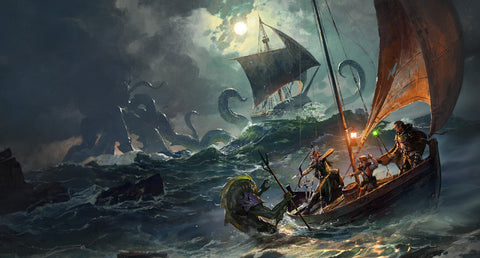
© Wizards of the Coast
Official DnD 5e Weather Rules
For those that absolutely DESPISE homebrew (or are playing in the Adventurer's League...) here are all the pages in official published content that features weather. As always, if I missed something, let me know in the comments!
Dungeon Master's Guide Pages 109 – 110:
- Extreme Cold: CON saves, DC 10, fail = level of exhaustion.
- Strong Wind: Disadvantage on hearing-based Perception, long ranged attacks, and flying. Puts out unprotected flames.
- Extreme Heat: CON saves, fail = level of exhaustion. Increase DC by 5 for every hour they don't get water.
- Heavy Precipitation: Disadvantage on sight-based perception checks, everything is lightly obscured.
- Frigid Water: Can be immersed in freezing water for a number of minutes equal to CON ability modifier. Then make CON saves, fail = level of exhaustion.
- Ice: DC 10 acrobatics check.
- High Altitude: every hour of travel counts as two hours.
Ghosts of Saltmarsh Pages 201 – 205: Random tables and DC settings for normal and magical Dnd 5e weather at sea (mist, fog, and storms) and rules for light and pressure for different depths of water:
- Fog: different DCs for different intensity of fog, and four levels of its impact on the party's ability to navigate.
- Storm: different DCs for different intensity of storms, and four levels of its impact on the ship/party's HP.
- Water Depth: 3 different sea zones and their impact on visibility, how much temperature changes at depth, and an optional rule for what objects break at which depth.
- Eldritch Mist: 3 different types of mist (Ghost Fog, Shadowfell Fog, and Wild Magic Fog) and two random tables for the thickness and obfuscation of the fog (this stuff is LEGIT).
- Magical Storms: Specific monsters and effects for the 8 original schools of magic. For example: an enchantment storm would impose disadvantage on all crew members, and abjuration storms TELEPORT ships 5d20 miles!!!
Tasha's Cauldron of Everything Pages 150 – 164: Regional effects from supernatural planar locations, as well as unique eldritch storms. D100 tables for environments that have "Blessed Radiance," "Farm Realm," "Haunted," "Psychic Resonances," "Unraveling Magic," and "Eldritch Storms."
Rime of the Frostmaiden Pages 10 – 11: Rules for surviving in artic and freezing environments! Includes rules for extreme cold temperature and water, but they are repeats of the rules in the DMG:
- Avalanches: an avalanche is 300ft wide, 150ft long, and 30ft thick. They have their own initiative and a movement speed of 300ft per round. Players that fail a DC Strength saving throw take bludgeoning damage and are buried. While buried, they are blinded and restrained. They take a level of exhaustion every 5 minutes they spend trying to dig themselves out.
- Blizzards: high speed winds impose disadvantage on ranged weapon attacks and Perception checks that rely on sight and hearing. Flames, fog, and tracks are blown away. Physical flight is impossible. Every round of combat, concentration saves must be made by spellcasters whether or not they were attacked. DC 15 Survival check is needed both for navigation and finding missing party members.
Tomb of Annihilation Page 11: Explanation of the types of DnD weather players can expect in a jungle. Some visibility guidelines for heavy rain and CON saves for humid, hot weather:
- Tropical temperature ranges between 70s and high 90s.
- Visibility limited by heavy rain outside of 50 yards.
- It is considered impossible to travel during a tropical storm. Any attempts to do so imposes an AUTOMATIC level of exhaustion on all players AND immediately requires they make a DC 10 CON save or take another.
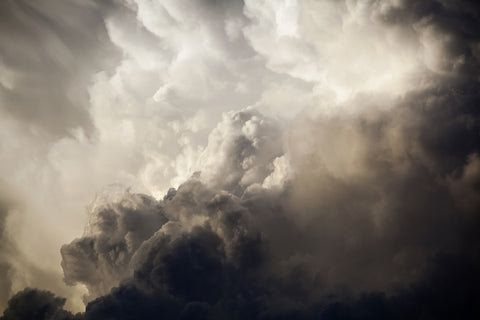
DnD 5e Weather Generators and Random Tables
In my opinion, the best and first way you should implement weather into your campaigns is by having it reflect the plot and development of the player characters. If I didn't believe that, I wouldn't have spent all that time on symbolism.
But Dungeons & Dragons is not just shared storytelling... it's also a game... and in this game, DM and players do not play improv because there is another position of agency: the DICE. And just like a windy day will change your weekend paragliding plans, a true game of D&D 5e will often include making space for the dice to decide what happens next. And there is no better and easier way to do this than with random tables.
By using random tables, you can generate a wide variety of weather conditions, including temperature, precipitation, wind speed, and visibility. You can create your own random tables and make them as detailed as you want, or find ready-to-use ones in various DnD resources.
Here are my favorite ones I found online, because the one page of the DMG (109) isn't nearly thorough enough:
- GM Binder has a PDF with both simple tables and some additional weather effects, complete with DC saves (get it here).
- RPGBOT has a great post on the effect of temperature on your players, something to keep in mind when they are wearing heavy armor (read it here).
- Clash of Spear and Shield has a simple d100 table that includes temperature, precipitation, and wind. However, it provides no rules for any of them, and it would all be relative to the region your party is journeying through (check it out here).
- There is one generator that I LOVE and use above all others: Fantasy Weather Generator 0.18. IMO it is the BEST because it doesn't do weather for just one day, but for up to 30 days! This is extremely helpful when your players are traveling to their destination and you want to plan for encounters along the way.
- Another one is Donjon, which is much more simple and only for one day. It also adds randomly generated AI art, though I have no idea why. The best benefit is that it includes any special rules for that particular weather at the bottom.
By rolling on these tables or using these generators at the start of each in-game day or during specific events, you can introduce weather changes that impact your players' strategies, decisions, and overall experience.
Conclusion: Why is Weather Important for My D&D Campaigns?
Weather is essential for D&D campaigns as it adds realism, depth, and atmosphere to your adventures. It enhances the storytelling elements, creates memorable moments, and introduces challenges for your players during exploration and combat encounters.
Adventures in Dungeons & Dragons become more immersive when weather is utilized as a storytelling tool. It adds depth to your fantasy worlds, impacts the plot, and symbolically enhances player characters' development. Just as weather impacts our real lives, it can shape the narrative of your D&D campaign. Embrace the power of DnD 5e weather tables and rules to create a truly unforgettable adventure for your players!
Riley Rath

Riley is a freelance copywriter, content writer, and marketer based out of Spokane, WA. He is thankful to have the opportunity to combine his passion for imaginative role-playing to help FLGS, tabletop, board game, and D&D related businesses communicate their distinct value to players everywhere. When not playing or writing about board games or DnD, he is busy hiking, cooking, and gardening... very hobbit-like for a 6'4" dude.

